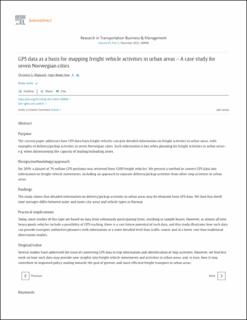| dc.contributor.author | Mjøsund, Christian S. | |
| dc.contributor.author | Hovi, Inger Beate | |
| dc.coverage.spatial | Norway, Oslo | en_US |
| dc.date.accessioned | 2023-06-14T08:10:01Z | |
| dc.date.available | 2023-06-14T08:10:01Z | |
| dc.date.created | 2022-11-07T13:18:08Z | |
| dc.date.issued | 2022-11-01 | |
| dc.identifier.citation | Research in Transportation Business and Management (RTBM). 2022, 45 (Part C), 1-11. | en_US |
| dc.identifier.issn | 2210-5395 | |
| dc.identifier.uri | https://hdl.handle.net/11250/3071278 | |
| dc.description | Published by Elsevier Ltd. This is an open access article under the CC BY license (http://creativecommons.org/licenses/by/4.0/). | en_US |
| dc.description.abstract | Purpose The current paper addresses how GPS data from freight vehicles can give detailed information on freight activities in urban areas, with examples of delivery/pickup activities in seven Norwegian cities. Such information is key when planning for freight activities in urban areas– e.g. when dimensioning the capacity of loading/unloading zones. Design/methodology/approach For 2019, a dataset of 79 million GPS positions was retrieved from 1200 freight vehicles. We present a method to convert GPS data into information on freight vehicle movements, including an approach to separate delivery/pickup activities from other stop activities in urban areas. Findings The study shows that detailed information on delivery/pickup activities in urban areas may be obtained from GPS data. We find that dwell time averages differ between outer and inner-city areas and vehicle types in Norway. Practical implications Today, most studies of this type are based on data from voluntarily participating firms, resulting in sample biases. However, as almost all new heavy goods vehicles include a possibility of GPS tracking, there is a vast future potential of such data, and this study illustrates how such data can provide transport authorities/planners with information at a more detailed level than traffic counts and at a lower cost than traditional observation studies. Original/value Several studies have addressed the issue of converting GPS data to trip information and identification of stop activities. However, we find less work on how such data may provide new insights into freight vehicle movements and activities in urban areas, and, in turn, how it may contribute to improved policy making towards the goal of greener and more efficient freight transport in urban areas. | en_US |
| dc.description.abstract | GPS data as a basis for mapping freight vehicle activities in urban areas – A case study for seven Norwegian cities | en_US |
| dc.language.iso | eng | en_US |
| dc.publisher | Elsevier Ltd | en_US |
| dc.subject | GPS data | en_US |
| dc.subject | Urban logistics | en_US |
| dc.subject | Road transport | en_US |
| dc.subject | Delivery times | en_US |
| dc.title | GPS data as a basis for mapping freight vehicle activities in urban areas – A case study for seven Norwegian cities | en_US |
| dc.title.alternative | GPS data as a basis for mapping freight vehicle activities in urban areas – A case study for seven Norwegian cities | en_US |
| dc.type | Journal article | en_US |
| dc.type | Peer reviewed | en_US |
| dc.rights.holder | © 2022 The Authors. | en_US |
| dc.source.articlenumber | 100908 | en_US |
| dc.description.version | publishedVersion | en_US |
| cristin.ispublished | true | |
| cristin.fulltext | original | |
| cristin.qualitycode | 1 | |
| dc.identifier.doi | 10.1016/j.rtbm.2022.100908 | |
| dc.identifier.cristin | 2069985 | |
| dc.source.journal | Research in Transportation Business and Management (RTBM) | en_US |
| dc.source.volume | 45 | en_US |
| dc.source.issue | Part C | en_US |
| dc.source.pagenumber | 1-11 | en_US |
| dc.relation.project | Norges forskningsråd: 283333 | en_US |
